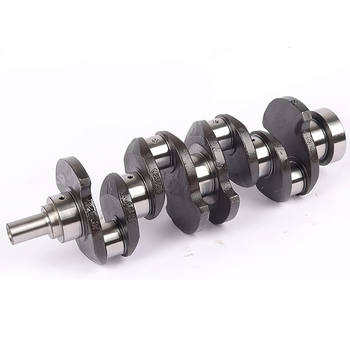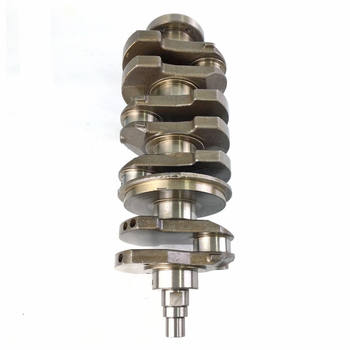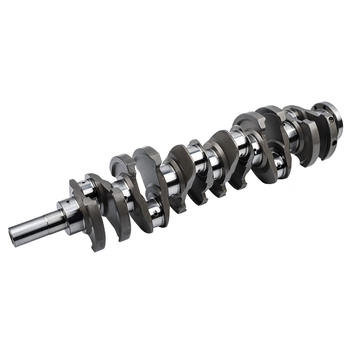The Unsung Heroes: What Makes a Leading Crankshaft Manufacturer?
Every engine, from the smallest lawnmower to the largest marine vessel, relies on a critical component: the crankshaft. It’s the very heart of the internal combustion engine, converting the linear motion of pistons into rotational energy that powers everything from your car’s wheels to massive industrial machinery. Frankly speaking, without a perfectly engineered crankshaft, an engine is little more than a collection of inert metal parts. And behind every reliable engine stands a dedicated crankshaft manufacturer, a specialist whose expertise in metallurgy, precision engineering, and quality control is paramount.
Have you ever wondered about the immense forces a crankshaft endures? Think about it: constant explosions, extreme temperatures, and incredible rotational speeds. This isn't a part that can afford to fail. This is why the role of a top-tier crankshaft manufacturer is so crucial. They don't just make metal parts; they craft components that are the backbone of modern power generation, designed to withstand immense stress and perform flawlessly for millions of cycles. To be honest, it's a testament to human ingenuity and manufacturing prowess.
The Intricate Dance of Precision: Understanding Crankshaft Manufacturing
The journey of a crankshaft from raw material to a finished, high-performance component is a complex and fascinating one, demanding an unparalleled level of precision and technological sophistication. It's a multi-stage process where each step is critical to the final product's integrity and performance. Many experts agree that the foundation of a superior crankshaft lies in the initial material selection and forming process.
Forging vs. Casting: The Foundation
The first major decision a crankshaft manufacturer makes involves how to form the initial shape of the crankshaft. The two primary methods are forging and casting, each with distinct advantages and disadvantages.
- Forging: This method involves heating a solid steel billet and then shaping it under immense pressure using dies. The forging process aligns the grain structure of the metal, making the crankshaft incredibly strong, ductile, and resistant to fatigue. Forged crankshafts are typically preferred for high-performance engines, heavy-duty applications, and where maximum durability is required. It's a more expensive and labor-intensive process, but the superior mechanical properties often justify the cost.
- Casting: In contrast, casting involves pouring molten metal into a mold. While more economical and suitable for mass production, cast crankshafts generally have a less uniform grain structure and are inherently weaker than forged ones. They are commonly used in standard automotive engines where cost-effectiveness is a primary concern and the stress levels are within acceptable limits for cast iron or steel.
Interestingly enough, the choice between forging and casting often dictates the subsequent machining processes and the ultimate performance characteristics of the crankshaft. A leading crankshaft manufacturer will have expertise in both, advising clients on the most suitable method for their specific application.
Machining: The Art of Shaping
Once the basic form is established, the real magic of precision crankshaft manufacturing begins. This stage involves removing material to achieve the exact dimensions, surface finishes, and geometric tolerances required. This is where advanced CNC (Computer Numerical Control) machining centers come into play, capable of executing complex cuts with incredible accuracy.
- Rough Machining: Initial cuts remove excess material, bringing the crankshaft closer to its final shape.
- Finish Machining: This involves precise turning, milling, and drilling operations to create the main bearing journals, rod bearing journals, counterweights, and other critical features. Tolerances here are often measured in microns.
- Grinding and Polishing: The journals, which support the connecting rods and the crankshaft itself, must have exceptionally smooth and hard surfaces to minimize friction and wear. Specialized grinding machines achieve the required surface finish, followed by polishing for an even finer texture.
The precision required at this stage cannot be overstated. Any deviation, even microscopic, can lead to premature wear, excessive vibration, or catastrophic failure. It's worth noting that the expertise of the machinists and the calibration of the machines are as vital as the raw material itself.

Heat Treatment and Surface Finishing: Enhancing Durability
After machining, crankshafts undergo various heat treatment and surface finishing processes to enhance their strength, hardness, and wear resistance. These treatments are crucial for extending the lifespan of the component under extreme operating conditions.
- Nitriding: This process involves diffusing nitrogen into the surface of the steel, creating a hard, wear-resistant layer. It significantly improves fatigue strength and resistance to scuffing.
- Induction Hardening: Specific areas, particularly the bearing journals, are rapidly heated using electromagnetic induction and then quenched, making them extremely hard.
- Shot Peening: This mechanical process involves bombarding the surface of the crankshaft with small, high-velocity shots. This creates compressive residual stresses on the surface, which significantly improves fatigue life and resistance to cracking.
Balancing and Quality Control: The Final Touch
A crankshaft in an engine rotates at thousands of revolutions per minute. Any imbalance, however slight, can lead to severe vibrations, excessive wear on bearings, and ultimately, engine damage. Therefore, dynamic balancing is a critical final step. State-of-the-art balancing machines precisely measure and correct any imbalances by removing small amounts of material from the counterweights.
Beyond balancing, a comprehensive quality control regimen is implemented throughout the entire manufacturing process. This includes:
- Dimensional Inspection: Using CMM (Coordinate Measuring Machine) and other precision instruments to verify all dimensions and tolerances.
- Non-Destructive Testing (NDT): Techniques like magnetic particle inspection, ultrasonic testing, and eddy current testing are used to detect internal flaws, cracks, or material inconsistencies without damaging the part.
- Material Analysis: Ensuring the chemical composition and mechanical properties of the raw material meet specifications.
Frankly speaking, a leading crankshaft manufacturer invests heavily in these quality control measures, understanding that the reliability of their product directly impacts the performance and safety of the engines it powers.
Beyond the Engine Block: Diverse Applications of Crankshafts
While often associated with automotive engines, crankshafts are fundamental components in a vast array of machinery across numerous industries. The specific design and manufacturing requirements vary significantly depending on the application, showcasing the versatility and adaptability required of a proficient crankshaft manufacturer.
Automotive and Motorsport Crankshafts
This is perhaps the most familiar application. Automotive crankshafts range from those found in compact cars, designed for efficiency and mass production, to high-performance motorsport versions. For racing applications, the emphasis is on lightweight design, extreme strength, and the ability to withstand very high RPMs and stresses. This often involves using specialized alloys, intricate forging processes, and meticulous balancing. The demand for reliable automotive crankshaft suppliers is constant, driven by both new vehicle production and the aftermarket.
Marine and Industrial Heavy-Duty Crankshafts
At the other end of the spectrum are the massive crankshafts used in marine engines, power generators, and large industrial compressors. These components can weigh many tons and are designed for continuous operation under immense loads. Durability, longevity, and resistance to corrosion are paramount. The manufacturing processes for these giants are often unique, requiring specialized machinery and handling capabilities that only a few manufacturers possess globally. Their sheer scale and the critical nature of their application underscore the importance of robust engineering.
Specialized and Custom Crankshaft Production
Beyond standard applications, there's a significant demand for custom crankshaft production. This includes crankshafts for antique engine restoration, experimental engines, niche industrial machinery, or even bespoke power solutions. In these cases, a crankshaft manufacturer must be able to work closely with clients, often from initial design concepts, to produce low-volume or one-off components that meet unique specifications. This requires exceptional design flexibility, advanced prototyping capabilities, and a deep understanding of diverse engineering challenges. In my experience, these custom projects often push the boundaries of manufacturing innovation.

The Hallmarks of an Exceptional Crankshaft Manufacturer
Choosing the right crankshaft manufacturer is a strategic decision that can significantly impact the performance, reliability, and cost-effectiveness of any engine or machinery project. So, what sets the truly exceptional manufacturers apart from the rest?
Advanced Technology and R&D
A leading manufacturer is always at the forefront of technological advancement. This means investing in the latest CNC machines, advanced simulation software for design and stress analysis (like FEA - Finite Element Analysis), and innovative heat treatment processes. They also dedicate resources to research and development, exploring new materials, manufacturing techniques, and design optimizations to improve performance, reduce weight, or enhance durability. Many experts agree that continuous innovation is key in this competitive industry.
Material Expertise and Sourcing
The quality of the raw material is non-negotiable. An excellent crankshaft manufacturer possesses profound knowledge of various steel alloys, their properties, and their suitability for different applications. They maintain stringent control over their material sourcing, working only with reputable suppliers to ensure consistent quality and traceability. Understanding how different alloys respond to forging, machining, and heat treatment is a specialized skill that comes with years of experience.
Rigorous Quality Assurance
As discussed, quality control is paramount. An exceptional manufacturer implements a comprehensive quality management system that covers every stage, from incoming raw materials to the final inspection of the finished product. This often includes ISO certifications, adherence to industry-specific standards, and a culture of continuous improvement. They don't just inspect for defects; they strive for perfection, ensuring every crankshaft meets or exceeds the most demanding specifications.
Customer-Centric Approach and Technical Support
Beyond manufacturing prowess, a truly great crankshaft manufacturer acts as a partner to their clients. They offer strong technical support, assisting with design optimization, material selection, and troubleshooting. They are responsive, flexible, and committed to understanding and meeting the unique needs of each customer. This collaborative approach, in my experience, fosters long-term relationships and leads to superior outcomes.
Navigating Challenges and Embracing Innovation in the Crankshaft Industry
The crankshaft manufacturing industry is not static; it faces evolving challenges and embraces continuous innovation to meet the demands of a dynamic global market. These challenges often drive the very advancements that define the next generation of power systems.
Environmental Regulations and Sustainability
With increasing global awareness and stricter environmental regulations, there's a growing push for more fuel-efficient and lower-emission engines. This translates into demands for lighter, stronger crankshafts that can operate more efficiently. Manufacturers are exploring advanced lightweight materials, optimizing designs to reduce rotational inertia, and adopting more sustainable manufacturing processes to minimize waste and energy consumption. It's worth noting that sustainability is no longer just a buzzword; it's a core operational principle.
Digitalization and Industry 4.0
The advent of Industry 4.0 is transforming manufacturing. A modern crankshaft manufacturer is increasingly integrating automation, robotics, IoT (Internet of Things) sensors, and data analytics into their operations. This allows for greater precision, reduced human error, predictive maintenance of machinery, and optimized production flows. Digital twins, virtual simulations of the manufacturing process, are also becoming more common, enabling manufacturers to identify and resolve potential issues before physical production even begins.
Global Supply Chain Dynamics
The global nature of manufacturing means that supply chain resilience is a constant concern. Geopolitical events, natural disasters, and economic fluctuations can disrupt the flow of raw materials and components. Leading manufacturers are diversifying their supply chains, building stronger relationships with suppliers, and implementing robust risk management strategies to ensure uninterrupted production and timely delivery. Frankly speaking, a reliable supply chain is as critical as manufacturing capability itself.

Choosing Your Ideal Crankshaft Manufacturer: A Strategic Decision
For businesses requiring crankshafts, whether for new engine production, aftermarket parts, or specialized applications, selecting the right manufacturing partner is a strategic decision that impacts quality, cost, and delivery. Here are key considerations:
Reputation and Experience
Look for a manufacturer with a proven track record, extensive experience in your specific application area, and positive client testimonials. Longevity in the industry often signifies reliability and expertise.
Capacity and Lead Times
Assess their production capacity to ensure they can meet your volume requirements, whether it's a single prototype or thousands of units. Understand their typical lead times and their ability to handle urgent orders.
Cost-Effectiveness vs. Quality
While cost is always a factor, it should never compromise quality, especially for a critical component like a crankshaft. A reputable manufacturer might not always be the cheapest, but their investment in quality control, R&D, and customer support often translates into long-term savings through reduced failures and improved performance. I've found that cutting corners on crankshaft quality inevitably leads to higher costs down the line.
Ultimately, the success of any engine application hinges significantly on the expertise and quality provided by its chosen crankshaft manufacturer. They are the silent architects of power, ensuring that the heart of every engine beats reliably and efficiently. As technology advances and demands evolve, the role of these specialized manufacturers will only grow in importance, continuing to drive innovation in power generation across the globe.
For more detailed information, please visit our official website:crankshaft manufacturer
About the author: Dr. Evelyn Reed is a seasoned mechanical engineer with over two decades of experience in powertrain design and manufacturing. Specializing in high-performance rotating machinery, her work has spanned automotive, marine, and industrial applications. She holds multiple patents in advanced material processing for engine components and is a passionate advocate for precision engineering and sustainable manufacturing practices.
 The Unseen Powerhouse: Unveili
The Unseen Powerhouse: Unveili
 Unveiling the Precision: The A
Unveiling the Precision: The A
 Navigating the World of Cranks
Navigating the World of Cranks
 The Unsung Heroes: What Makes
The Unsung Heroes: What Makes
